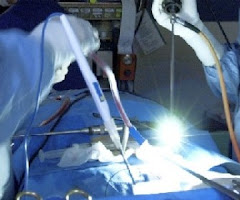Spinal stenosis is a narrowing of the space called the spinal canal, a small space in the backbone that contains the spinal cord and the sensory and motor nerve roots that run from the brain and out from the spinal cord to all parts of the body. The spinal canal is like a tunnel which runs up and down the human spine. This canal sits directly behind the bone blocks which make up the spine (vertebrae).
A normal spinal canal tunnel contains some free space between the important neurologic (nerve) structures it houses, such as the spinal cord and the nerve roots and the edges of the spinal canal. The canal is surrounded by bone and ligaments and therefore cannot expand if the spinal cord or nerves require more room. Therefore, if anything begins to narrow the spinal canal, there is risk for irritation or injury of the spinal cord or nerves. The spine may become narrowed in any of three areas: in the space at the center of the spine, in the canals where nerves branch out from the spine, and in the space between the bones of the spine (vertebrae).
When an abnormality causes a narrowing of a canal then the neurologic (nerve) structures within that canal can become irritated or compressed. This can lead to a variety of symptoms ranging from tingling, numbness, and weakness to severe pain and paralysis. The most common conditions which can narrow a spinal canal and cause stenosis include herniated discs (often called slipped discs), a fracture of the spine, tumors, infection and degeneration through the aging process.
Stenosis can occur anywhere along the spine but most commonly occurs in the lower spine (lumbar) region. Lumbar spinal stenosis can cause nerve compression which leads to persistent pain in the buttocks, limping, lack of feeling in the lower extremities, and decreased physical activity. Additional symptoms from lumbar spinal stenosis include sensations of heaviness, weakness and pain with walking or prolonged standing. There are several different forms of lumbar spinal stenosis.
The most common form of lumbar spinal stenosis is degenerative stenosis, which occurs to some degree in virtually the entire adult population as a result of the natural process of aging. This form of stenosis is a degenerative narrowing of the spinal canal, the nerve root canals or the intervertebral foramina caused by an unnatural enlargement (hypertrophy) of intervertebral discs, bones or ligaments. The narrowing results in compression of spinal nerves and nerve roots, causing a range of symptoms, including lower back pain, limping or impaired gait as a result of reduced blood supply to the leg muscles (neurogenic claudication) and lower extremity pain.
Congenital lumbar stenosis is relatively rare and usually appears at an early age, often between 30 and 40. The congenital form of spinal stenosis is seen in individuals who are born with a narrow spinal canal. In these individuals, even minimal changes in the structure of the spine brought on by age can cause severe spinal stenosis. Congenital spinal stenosis is largely a mysterious condition that can neither be predicted nor prevented. The onset does not distinguish by sex, race, or ethnicity, and is not associated with any particular occupation or any particular body type.
Acquired lumbar spinal stenosis is more common and generally develops in persons who are in their 60s or older. This form of stenosis is caused by progressive changes in different spinal elements (such as the discs, joints, ligaments, etc.) As people age, all these different elements sag or bulge and form arthritis that narrows the spinal canal.
Treatment for spinal stenosis ranges from physical therapy to epidural injections and finally surgery in certain cases. Arthroscopic surgery for spinal stenosis has a high success rate in patients carefully selected for this procedure. It remains a useful approach in treatment when other options have been exhausted and after careful review of risks and benefits with the patient.
Thursday, July 10, 2008
Subscribe to:
Post Comments (Atom)


3 comments:
I need help and was told there is none. could you please have someone contact me ASAP
Sincerely,
Myrna
Thank you for sharing the post which gives information about what is actually Spinal Stenosis. laser surgery for spinal stenosis Houston, TX
If the source is not treated, the spider veins will soon return. Lasers are seldom as effective as sclerotherapy for spider veins. charlottesville rhinoplasty surgeons
Post a Comment